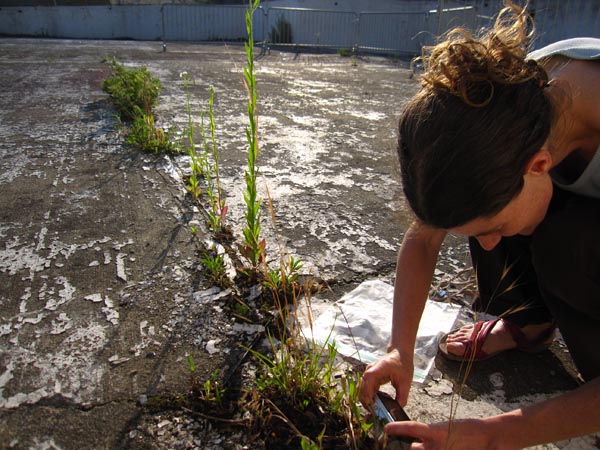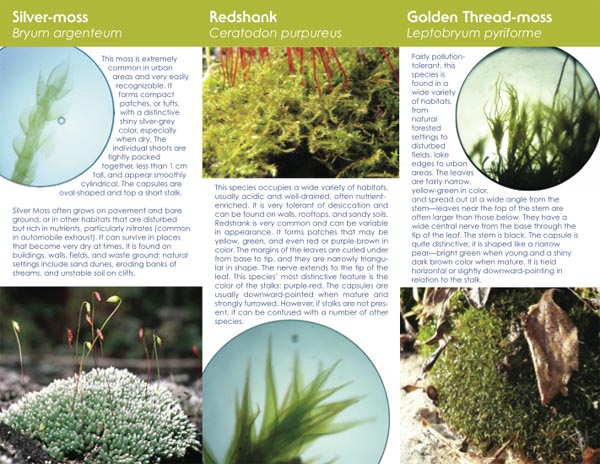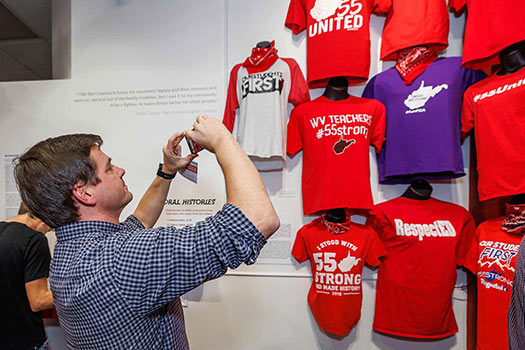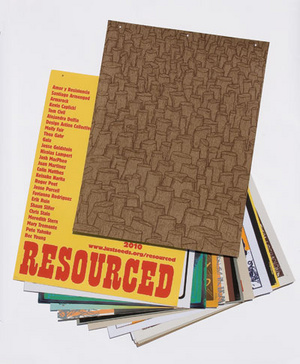
I admittedly knew very little about mosses when we pitched the idea, and relied heavily on Jessica’s willing expertise and reading recommendations to develop some sort of knowledge foothold. It reminded me of when I first got nerdy about fungi, except in this case I was cramming months of book-learning into a production deadline. Jessica is also a pro with microscope identification, which, it turns out, is often a necessary step in really nailing down species identification for moss.

With our budget, Jessica and I were able to produce and print a tri-fold brochure detailing the three dominant mosses in the pool. We profiled Silver-moss (Bryum argenteum), Redshank (Ceratodon purpureus), and Golden Thread-moss (Leptobryum pyriforme), and included some summary information about moss habitats in urban environments. The brochures will be available on-site at the pool, and we’ll also be distributing them in the surrounding neighborhood (tactics for this are TBD). As a nod to my childhood fascination with field guides, I designed the cover of the brochure to mimic the old Golden Guides I had when I was young. Back then the covers and innards were entirely hand-painted, a career move suggested by my high school guidance counselor during sophomore year. I still wonder sometimes what my life would look like if I had followed her advice.

For the pool itself, I fabricated a series of wood-and-brass plaques, installed on the concrete pool floor near large colonies of moss, labeling them in an aesthetic manner meant to echo the historical style of European botanical conservatories.

Project: Lido officially opens to the public on August 30. The pool is located at 4700 Butler Avenue in the Lawrenceville neighborhood of Pittsburgh.
Recommended reading on moss, and general inspirational observations about the microworld that surrounds us: Gathering Moss: A Natural and Cultural History of Mosses, by Robin Wall Kimmerer
Here’s the summary text from the brochure:
Moss is all around us, even in urban environments like Pittsburgh, where concrete and masonry dominate the visual landscape. While moss is generally associated with the damp cover of a dense forest, it can often be found thriving in surprising places. There are 22,000 species of moss worldwide.
True mosses are distinct from other plants because they lack flowers, fruits, seeds, a vascular system, and roots. Because they have no veins or roots to move water, they must absorb water directly through their tissues. Their small size, however, means that they inhabit a world with different physical properties than larger plants. Mosses thrive in what’s known as the “boundary layer,” a nearly motionless, still layer of air right at the surface of a rock, log, or sidewalk. Boundary layers trap heat as well as water vapor, creating a humid zone where mosses flourish. When gases such as carbon dioxide emanate from the surface of a decomposing log, they are also trapped in the boundary layer in higher concentrations than the air above. This microclimate creates an ideal setting within which moss can photosynthesize using available resources before the air current carries the moisture and beneficial gases upward. Although all mosses are relatively small, structural variations help them to specialize in different environments. Mosses adapted to dry conditions, for example, often have relatively short stalks clustered in tufts and long narrow leaf tips; these features help to protect against sunburn and to conserve water.
Mosses reproduce by distributing spores into the air from capsules on stalks called setae. The spores are then transmitted up into the atmosphere where they travel indefinitely. Eventually, these spores rain back down onto the landscape, so the same moss found in a decommissioned pool in Pittsburgh could also be found growing on a cliff in Mongolia.
The mosses growing in the former Leslie pool respond to several features of their concrete habitat. The pool becomes extremely dry, so resident flora must be tolerant of drought. Some mosses do this by entering a kind of stasis when dry, resuming growth again when they become wet. The painted concrete surface of the pool is mostly smooth and impervious, but in cracks and corners some sediments have accumulated. This surface provides no medium for larger plants to root into or to store water, which runs off immediately. However, many mosses are adapted to grow on such surfaces or to utilize tiny areas of soil that larger plants cannot; they are perfectly adapted to take advantage of this wide-open habitat, where light is abundant and competition is scarce.The urban environment offers considerable amounts of air pollution; city mosses must be able to survive acid deposition and other chemical assaults. However, motor vehicle exhaust also includes high levels of nitrates, which are deposited on surfaces near roadways. Two of the most common urban mosses, Silver Moss and Redshank, may take advantage of this nutrient enrichment; even in more natural settings, they generally occupy nitrate-rich areas.
Many of the species found in the Leslie pool are now primarily encountered in urban settings and other areas disturbed by humans. Such habitats have existed for many thousands of years, and these species have adapted to take advantage of them. However, they are also found in natural settings that share similar characteristics. Soil on cliffs, for example, may be similarly dry and shallow; decomposing plant and animal waste provides natural nitrate enrichment.







